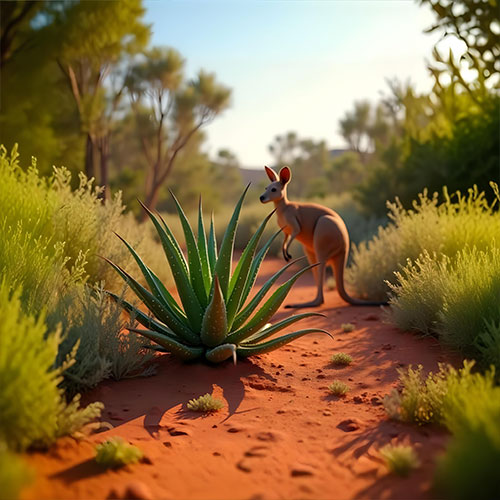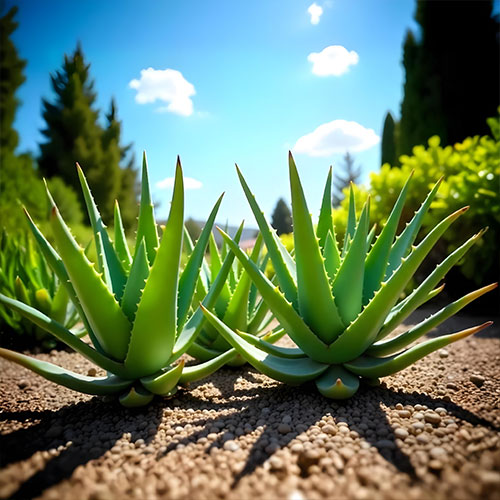






Aloe vera, known for its healing and hydrating properties, has made an impact around the world. In the 19th century, it made its way to Australia, where it found a perfect home in the country’s arid and semi-arid regions. This blog takes a look at the journey of aloe vera to Australia, its thriving presence in the harsh Australian climate, and how it has become an integral part of both traditional remedies and modern sustainability practices.
In the 19th century, European settlers introduced aloe vera to Australia. With its medicinal value and versatility, it was quickly embraced by farmers and communities in the country. Aloe vera plants were shipped in crates labeled "Medicinal Plants," arriving at Australian harbors, where they were carefully unloaded and inspected for their potential.
Once the plant was introduced to Australia, it found an ideal home in the arid and semi-arid regions of the country. These regions, known for their dry, harsh climates, were well-suited for aloe vera’s hardy nature. The plant’s ability to withstand extreme conditions allowed it to thrive, quickly becoming a valuable asset for Australian farmers and communities.
Australia’s arid landscape is characterized by vast deserts, red soil, and rugged terrain. Yet, despite the challenging conditions, aloe vera flourished across the country. Its natural resilience allowed it to thrive where many other plants would struggle.
Aloe vera’s thick, water-storing leaves are perfectly adapted to the dry Australian environment, allowing it to survive with minimal water. As aloe vera began to spread across the Australian outback, it became a symbol of the country’s unique ability to adapt to its harsh climate. The plant’s vibrant green leaves dotted the red earth, a striking contrast to the vast expanses of land. Aloe vera’s survival in such challenging conditions spoke to its strength and versatility.
Recognizing aloe vera’s potential, farmers across Australia began to cultivate the plant. Its versatility in skincare, wellness, and traditional remedies made it an attractive crop for agricultural development.
Farmers carefully harvested aloe vera leaves, which contain a clear, gel-like substance prized for its soothing and healing properties. Aloe vera cultivation was embraced across the country, particularly in the outback regions, where the plant thrived in the dry, warm climate. The farming of aloe vera became a significant agricultural activity, contributing to both local economies and the growing wellness industries.
In rural areas, aloe vera was seen not only as a crop for industry but also as a valuable plant for everyday life. The translucent gel within the leaves was used in skincare routines, herbal remedies, and even in treating sunburns—a common issue in Australia’s hot, sunny climate.
Aloe vera quickly became a staple in Australian households. Known for its cooling, healing properties, the gel from its leaves was commonly applied to sunburns, cuts, and other skin irritations. Whether used in rural homes or by city dwellers, aloe vera was an accessible and effective remedy.
As its popularity grew, aloe vera also became part of Australia’s wellness industry. It was incorporated into a variety of skincare products, from lotions and creams to moisturizers and facial masks. Small rural factories processed the aloe vera leaves into products that could be sold locally and internationally, contributing to the country's growing natural skincare market.
In recent years, aloe vera has also found a role in Australia’s growing focus on sustainability and eco-friendly farming practices. The plant’s minimal water requirements and hardiness make it an ideal crop for sustainable farming in Australia’s dry regions.
Modern Australian aloe vera farms are embracing innovative and eco-conscious practices, from using drones to monitor crop health to promoting organic farming techniques. Aloe vera is seen not just as a valuable product but as part of a larger effort to create sustainable and environmentally-friendly agricultural practices.
Aloe vera’s presence in Australia today is a testament to its versatility, thriving in both traditional agricultural settings and modern sustainability initiatives. Its ability to support the wellness industry and contribute to eco-friendly farming practices makes it an important part of Australia’s agricultural future.
From its arrival in the 19th century to its modern-day role in Australian households and farms, aloe vera has become deeply embedded in the country’s culture and landscape. Whether used for its healing properties, incorporated into skincare routines, or cultivated as part of sustainable farming practices, aloe vera has proven to be a resilient and valuable plant in Australia’s arid climate.
Today, aloe vera continues to thrive in Australia, contributing to the natural skincare and wellness industries while supporting eco-friendly farming practices. Its journey from a medicinal plant to a sustainable crop reflects its enduring versatility and the ways in which it has become an integral part of Australian life.